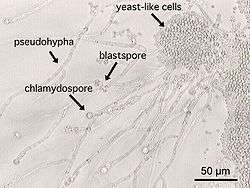Chlamydospore
A chlamydospore is the thick-walled large resting spore of several kinds of fungi, including Ascomycota such as Candida,[1] Basidiomycota such as Panus,[2] and various Mortierellales species.[3] It is the life-stage which survives in unfavourable conditions, such as dry or hot seasons.

Chlamydospores of the yeast Candida albicans
Chlamydospores are usually dark-coloured, spherical, and have a smooth (non-ornamented) surface. They are multicellular, with cells connected by pores in the septae between cells.
Chlamydospores are a result of asexual reproduction (in which case they are conidia called chlamydoconidia) or sexual reproduction (rare). Teliospores are special kind of chlamydospores formed by rusts and smuts.
See also
References
- ↑ Staib, P; Morschhäuser, J (2007). "Chlamydospore formation in Candida albicans and Candida dubliniensis--an enigmatic developmental programme". Mycoses. 50 (1): 1–12. doi:10.1111/j.1439-0507.2006.01308.x. PMID 17302741.
- ↑ Dennis, R. L. (1969). "Fossil mycelium with clamp connections from the middle pennsylvanian". Science. 163 (3868): 670–1. doi:10.1126/science.163.3868.670. JSTOR 1726335. PMID 17742734.
- ↑ Wagner, L.; Stielow, B.; Hoffmann, K.; Petkovits, T.; Papp, T.; V, C. (2013). "A comprehensive molecular phylogeny of the Mortierellales (Mortierellomycotina) based on nuclear ribosomal DNA". Persoonia. Naturalis Biodiversity Center. 30 (1): 77–93. doi:10.3767/003158513x666268. Retrieved 2016-02-11.
External links
- The chlamydospores of Candida albicans,
- Chlamydospore development
This article is issued from
Wikipedia.
The text is licensed under Creative Commons - Attribution - Sharealike.
Additional terms may apply for the media files.